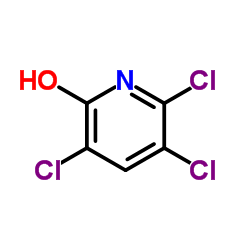3,5,6-Trichloro-2-pyridinol

3,5,6-Trichloro-2-pyridinol structure
|
Common Name | 3,5,6-Trichloro-2-pyridinol | ||
|---|---|---|---|---|
| CAS Number | 6515-38-4 | Molecular Weight | 198.434 | |
| Density | 1.7±0.1 g/cm3 | Boiling Point | 325.0±37.0 °C at 760 mmHg | |
| Molecular Formula | C5H2Cl3NO | Melting Point | 328-330ºC | |
| MSDS | Chinese USA | Flash Point | 150.4±26.5 °C | |
| Symbol |



GHS05, GHS07, GHS09 |
Signal Word | Danger | |
|
Non-invasive biomonitoring for PFRs and PBDEs: new insights in analysis of human hair externally exposed to selected flame retardants.
Sci. Total Environ. 505 , 1062-71, (2014) In this study, we investigated the hypothesis whether externally adsorbed and internally deposited flame retardants (FRs) in hair could be distinguished. To this extent, hair samples collected from one volunteer were exposed under controlled conditions to pho... |
|
|
Wettability and surface free energy of polarised ceramic biomaterials.
Biomed. Mater. 10(1) , 011001, (2015) The surface modification of ceramic biomaterials used for medical devices is expected to improve osteoconductivity through control of the interfaces between the materials and living tissues. Polarisation treatment induced surface charges on hydroxyapatite, β-... |
|
|
Octacalcium phosphate ceramics combined with gingiva-derived stromal cells for engineered functional bone grafts.
Biomed. Mater. 9(5) , 055005, (2014) Biocompatible ceramic fillers are capable of sustaining bone formation in the proper environment. The major drawback of these scaffolding materials is the absence of osteoinductivity. To overcome this limitation, bioengineered scaffolds combine osteoconductiv... |
|
|
Development and functional evaluation of biomimetic silicone surfaces with hierarchical micro/nano-topographical features demonstrates favourable in vitro foreign body response of breast-derived fibroblasts.
Biomaterials 52 , 88-102, (2015) Reproducing extracellular matrix topographical cues, such as those present within acellular dermal matrix (ADM), in synthetic implant surfaces, may augment cellular responses, independent of surface chemistry. This could lead to enhanced implant integration a... |
|
|
The murine serotonin syndrome - evaluation of responses to 5-HT-enhancing drugs in NMRI mice.
Behav. Brain Res. 277 , 204-10, (2014) In humans, the ingestion of the combination of two or more serotonin (5-HT)-enhancing drugs but also of a single drug in overdose can induce serious adverse effects, which are characteristics of the serotonin syndrome (SS). In mice, acute administration of di... |
|
|
Cell growth on pore-graded biomimetic TiO2 bone scaffolds.
J. Biomater. Appl. 29(9) , 1284-95, (2015) In order to prevent soft tissue down-growth into osseous defect areas, membranes are used when placing bone graft materials. These membranes still show shortcomings in their performance and applications. In the current study, we choose an approach to integrat... |
|
|
Self-assembling multidomain peptides tailor biological responses through biphasic release.
Biomaterials 52 , 71-8, (2015) Delivery of small molecules and drugs to tissues is a mainstay of several tissue engineering strategies. Next generation treatments focused on localized drug delivery offer a more effective means in dealing with refractory healing when compared to systemic ap... |
|
|
Modified screen-printed ion selective electrodes for potentiometric determination of sodium dodecylsulfate in different samples.
J. AOAC Int. 98(1) , 116-23, (2015) Fabrication and general performance characteristics of novel screen-printed sensors for potentiometric determination of sodium dodecylsulfate (SDS) are described. The sensors are based on the use of ion-association complexes of SDS with cetylpyridinium chlori... |
|
|
Biofabrication of cell-loaded 3D spider silk constructs.
Angew. Chem. Int. Ed. Engl. 54(9) , 2816-20, (2015) Biofabrication is an emerging and rapidly expanding field of research in which additive manufacturing techniques in combination with cell printing are exploited to generate hierarchical tissue-like structures. Materials that combine printability with cytocomp... |
|
|
Response of endothelial cells to decellularized extracellular matrix deposited by bone marrow mesenchymal stem cells.
Int. J. Clin. Exp. Med. 7(12) , 4997-5003, (2015) Evaluate the behavior and function of human umbilical vein endothelial cells (HUVECs) on decellularized extracellular matrix (ECM) deposited by bone marrow mesenchymal stem cells (BMSCs).Prepared through chemical approach, decellularized ECM was characterized... |